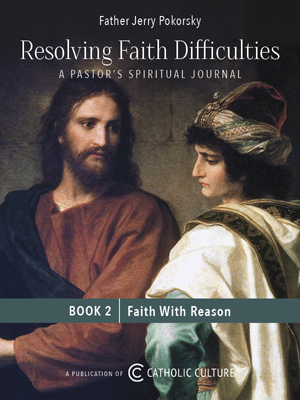Catholic Recipe: Quarter Bannock
Also Called: Oat Krisp, Oat Cake, Bannock, Bannoch
There is no doubt, as J. A. McCulloch writes on "Cakes and Loaves," that "some of the cakes which have a prominent place in folk usage at certain periods of the year, e.g., Christian festivals and holy days, as well as on other occasions, are probably lineally descended from cakes used sacrificially or sacramental in pagan times. This is suggested by the customs observed in the making of these cakes, or the eating of them; by their division among the members of the family, or by their being marked with sacred symbols." This fact seems to disturb some timid Christians who fail to recognize the wise philosophy and policy of the Catholic Church in missionary countries. So long as the native customs and habits were not in opposition to the law of nature or the law of God, they were not to be taken from the people.
The perfect example of this transfer from pagan to Christian is found in a study of the Scotch Highland Quarter Cakes. These were special cakes baked in a prescribed manner and used in pagan rites to celebrate the beginnings of the four seasons. They were all called bannocks, which is an oatcake cut as round as a dinner plate and baked on a hot griddle. Originally this cake was made with nine knobs on it. These knobs were gift offerings to the fox or the eagle or the "hooded crow" who might harm field and flock. The cake was washed over with a thin batter of "whipped egg, milk, cream and a little oatmeal." In time the knobs disappeared. A cross and a circle marked the opposite sides of the cake, and both were symbols of Christ's death and resurrection.
On August 1 the Bonnach Lunastain ushered in the harvest season. This day, as we said, was known as Lammas Day or Loaf Mass Day. The heathen cake was baked, it is true, but baked of the newly-harvested grain in thanksgiving for God's generosity and care. As the pagans sacrificed the fruits of the soil to the sun god, the newly baptized brought their bread to be blessed at the Loaf Mass. [Editor's Note: This feast is no longer celebrated on the General Roman Calendar.]
Part of this bread, which they made of the grain they had raised, was consecrated and changed into the Body and Blood of Christ. The greater part was blessed and taken home for the Lammas Day feast. And, if the loaf lasted more than a meal, the crumbs and leftovers were toasted and crumbled into a pot with butter and milk.
If you are curious, as we were, to see how a Quarter Bannock tastes, it is easy enough to make one. The only difficulty is buying the oat flour. We solved this problem by grinding n a hand mill the coarse oatmeal we could obtain at the store.
DIRECTIONS
Sift dry ingredients. Make a well in the center of dry ingredients. Add shortening and enough water to make a stiff dough. Rub plenty of meal on board. Pat out dough and roll one-eighth inch thick. Rub again with meal. Cut plate size and bake on hot greased griddle for 10 minutes on one side and 5 minutes on the other. Serve hot. (Barley meal and buttermilk may be substituted for the oats and hot water.)
Recipe Source: Cooking for Christ by Florence Berger, National Catholic Rural Life Conference, 4625 Beaver Avenue, Des Moines, IA 50310, 1949, 1999






